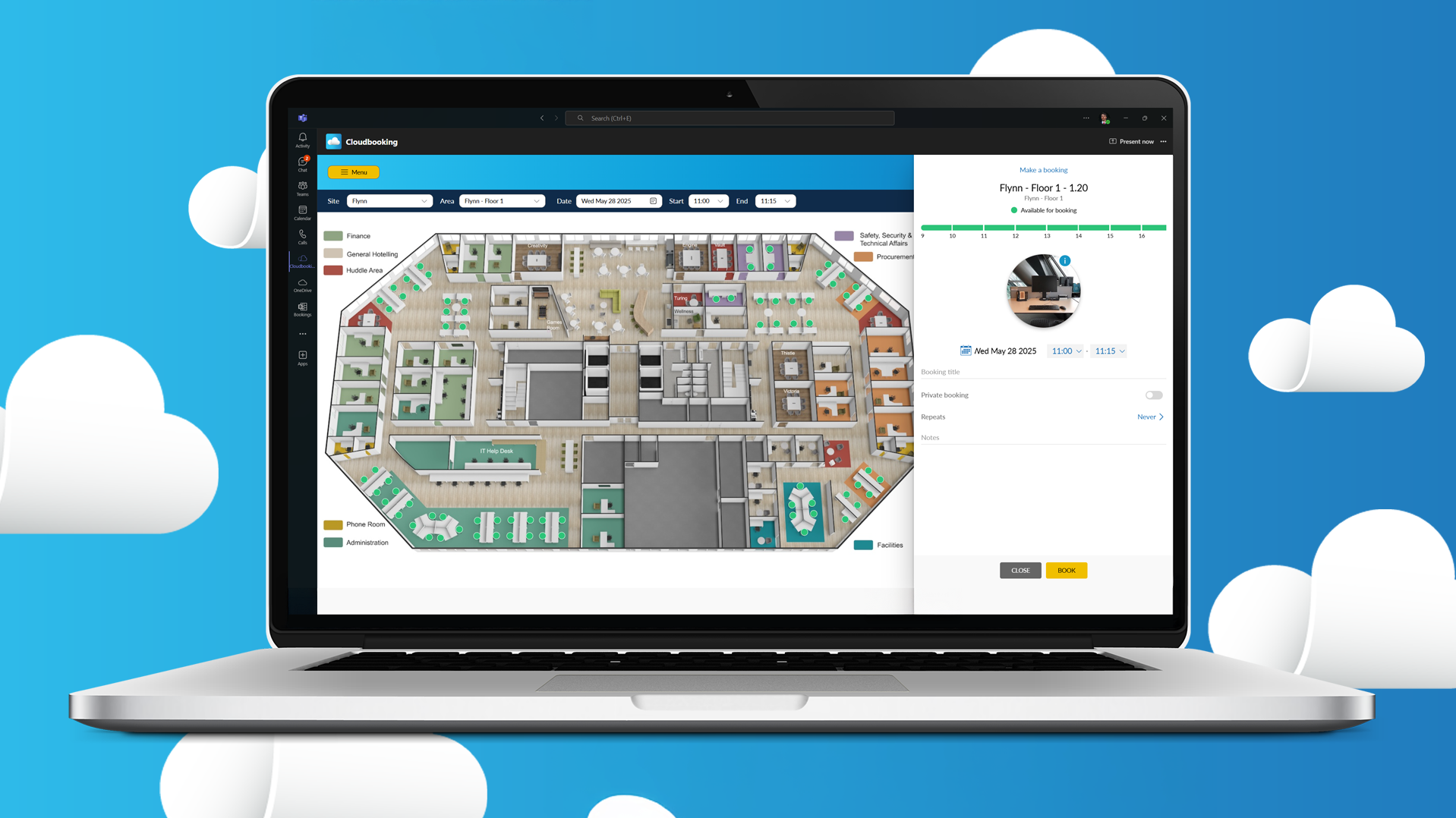
If you want to make the most out of your office space and increase workplace productivity, analysing the right occupancy metrics is an ideal method. Occupancy metrics analyse occupancy rate, workspace productivity and space utilisation. This helps organisations visualise the amount of office space required per person, enabling them to adjust their occupancy rate if needed.
Utilising occupancy metrics allows organisations to monitor current occupancy rates and identify trends that can be useful for informed decision-making. It’s a great way to optimise workspace efficiency and effectively manage office space through data-driven insights. Try analysing these eight occupancy metrics in your workspace.
Space utilisation rate
The space utilisation rate measures whether office space is being used efficiently. This metric looks at the occupancy rate — the number of people using a given amount of space versus workspace productivity, or the amount of work each person can do with their given office space.
Calculating occupancy rate and workspace productivity determines space utilisation, as it estimates what percentage of available space has been optimised in a company. Maximising workspace productivity and occupancy ensures businesses make the best use of all available resources, ultimately helping to increase overall efficiency and reduce waste.
By ensuring an optimal space utilisation rate, companies can streamline operations while also improving employee satisfaction. Both are core factors for successful business endeavours.
Related Reading: The Future of Work: 8 Trends in Workplace Transformation Report
Desk utilisation
Desk utilisation is a measure of occupancy rate used to analyse the quantity and efficient use of office space per person. Through tracking occupancy rates, organisations can determine the optimal number of workstations required to meet workspace productivity demands affordably.
Optimising desk utilisation enables organisations to determine suitable occupancy levels while reducing unnecessary expenses, such as renting too much office space or purchasing more desks than are required. In addition, properly managed occupancy levels enable organisations to reduce costs associated with cleaning and maintaining excess desks or other spaces without sacrificing workers’ environmental comfort and productivity.
Related Reading: Making Sense of Desk Sharing: How to Make It Work for Your Team
Meeting room utilisation
Meeting room utilisation is an important factor for any office environment. It refers to the occupancy rates of meeting rooms and how efficiently space is used in the workplace. Knowing which types of meetings are the most popular, how often certain rooms are used, occupancy rate and office space per person will enable organisations to monitor and optimise their workspace productivity levels properly.
This means occupancy levels can be maintained more effectively, leading to better use of meeting space with fewer resources, resulting in cost savings for the organisation.
With this kind of tracking, organisations can also ensure their spaces are scaled according to occupancy rates so that employees are provided with the right amount of space they need, creating a comfortable, productive working environment.
Related Reading: Meeting Room Booking: Informal vs Formal Spaces
Occupancy sensors
Occupancy sensors track occupancy rates and detect occupancy in a space. This technology is used in offices, retail stores, and public administration facilities to calculate occupancy per person and optimise space utilisation.
By using occupancy sensors, organisations can ascertain their workspace productivity by using occupancy information to improve comfort and save energy and resources. Across multiple industries, occupancy sensors can regularly monitor foot traffic and adjust system settings such as ventilation, temperature and lighting needs to better suit occupancy dynamics.
Besides making the indoor environment more comfortable, the technology is great for conserving resources such as electricity.
Related Reading: Businesses Are Wasting Billions of Pounds of Energy a Year
Employee density
Employee density is defined as how much office space there is per person in a given workplace. Businesses need to consider employee density due to the potential implications of this on workspace productivity, space utilisation, and employee experience.
Calculating employee density can be done using occupancy sensors, dynamic occupancy counts or manual occupancy counts, among other methods. Optimising your employee density can have many benefits, such as making the best use of office space, improved communication and collaboration amongst staff members, and improved operational efficiency.
Get it right and it can mean the difference between a productive workforce and an inefficient one.
Related Reading: How to Achieve Workplace Collaboration: Benefits, Pointers and More
Average desk vacancy duration
The average desk vacancy duration (or occupancy rate) is the time a workspace remains unoccupied between someone leaving the space and someone re-occupying it.
The occupancy rate indicates how effectively office space per person is being used and so is a key indicator of workspace productivity. Tracking occupancy rate has clear benefits: as one can identify spaces that are regularly unoccupied, optimising occupancy rate by redistributing resources or long-term planning to reduce space utilisation can enhance productivity and efficiency.
Knowing how to accurately track the occupancy rate is essential for successful workspace management.
Related Reading: What’s the Secret to Work-From-Home Productivity?
Real-time occupancy
By tracking real-time occupancy, companies can optimise the efficient use of their office space and increase productivity. This helps build a hybrid workplace culture that blends the best of remote work culture with the benefits of traditional offices.
Tracking real-time occupancy helps decrease the amount of travel between destinations while also enabling companies to operate more cost-efficient facilities by only heating or cooling spaces when necessary and ensuring efficient cleaning staff activities.
Real-time occupancy tracking can help organisations ultimately make better decisions on how they use their workspace and optimise resources, resulting in higher levels of productivity.
Related Reading: Desk Hoteling vs Hot Desking: Which One Should You Choose?
Visitor foot traffic
Visitor foot traffic is the number of people entering a building or space, usually over a particular period. It can be used to understand how efficiently your office space is being utilised and helps you to optimise productivity.
Tracking visitor foot traffic provides invaluable insights into improving the visitor experience and optimising their behaviour. For example, knowing when and where visitors arrive and leave is essential.
Utilising a visitor management system would prove beneficial in increasing the efficient use of the office space by understanding peak times and generating reports on visitor numbers.
Additionally, strategies such as providing efficient services, efficient wayfinding systems, and tailoring content can improve the overall visitor experience and optimise visitor foot traffic.
Related Reading: How to Create a Workplace Visitor Policy for the Post-Pandemic Workplace
The importance of occupancy metrics
Maximising efficient use of office space through occupancy metrics is essential for businesses to optimise productivity. The results can help organisations make informed decisions about current and future workplace layouts, as well as adjustments of lighting, air conditioning and soundproofing.
Moreover, the insights from occupancy metrics provide timely and actionable feedback that can help optimise your business environment even further. Efficient use of office space through occupancy metrics is an important factor when it comes to promoting business efficacy and growth.
Get more from your workspace
Efficient use of office workspace can be optimised with the right occupancy metrics. By understanding how workspaces are or aren’t being used, organisations can identify opportunities to adjust work practices or space allocations to best suit the needs of both employers and employees. Continuous monitoring and improvement are needed to ensure an efficient amount of space is maintained for workplace satisfaction and productivity.
Are you getting the most from your workspace? With Cloudbooking’s workspace management tools, you can take much greater control of your team’s efficiency and productivity. Take a look at our desk booking software, our visitor management resources, and meeting room booking capabilities.
Not sure what you need to truly get the most out of your office? Get in touch with the experts at Cloudbooking. Let’s transform your workplace.


